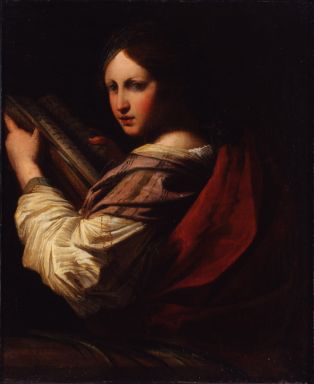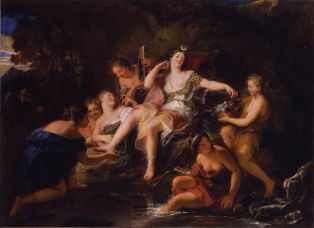- Découvrez les collections
- Notice d'oeuvre



Belluno, 1659 ; Venise, 1734
H. 62 cm ; l. 76 cm (sans cadre) ; H. 79,5 cm ; l. 93 cm (avec cadre)
M0536_L.I.56
Des moines cénobites, c’est-à-dire vivant en communauté, sont représentés en prière. Ils sont tourmentés par des démons : sur l’une des œuvres, le démon les menace avec des pierres, sur l’autre, une figure féminine ainsi qu’un démon symbolisent des tentations d’ordre charnel. Néanmoins, ces deux œuvres laissent espérer la victoire des hommes sur leurs tentateurs : un crucifix est figuré sur l’un, tandis que sur l’autre, une nuée avec deux anges apparaît. Les camaïeux ocres donnent une chaleur inattendue à la scène, le bleu du ciel apporte une nouvelle luminosité. L’œuvre de Sebastiano Ricci illustre le goût de l’époque pour les œuvres aux teintes travaillées et mouvementées : il est l’un des initiateurs de la peinture rococo qui triomphera au XVIIIe siècle. Marco (1676-1730), le neveu de Sebastiano, a certainement participé à la réalisation de ces deux tableaux. Lors de leur réalisation, Marco et Sebastiano sont en effet probablement à Florence, auprès d’Alessandro Magnasco (1667-1749). Ce dernier peint des scènes sombres où il laisse la part belle aux tentations, qui ont beaucoup inspiré Ricci.
Cenobites, or monks living in a community, are depicted at prayer. They are being tormented by demons: in one of the works the demon is threatening them with stones, and in the other a female figure and a demon symbolise the temptations of the flesh. Nevertheless, these two works express hope that the men will triumph over their tempters. A crucifix is depicted in one, and two angels can be seen in a cloud in the other. The palette of ochre tones add unexpected warmth to the scene and the blue sky brings a fresh light. Sebastiano Ricci’s work illustrates the taste of the period for works featuring skilful use of colour, creating a sense of action. He was one of the pioneers of Rococo painting, which would prevail in the 18th century. Marco (1676-1730), Sebastiano’s nephew, would certainly have been involved in the execution of these two paintings. Marco and Sebastiano were probably in Florence, working with d’Alessandro Magnasco (1667-1749) when they were painted. Magnasco painted sombre scenes, placing the emphasis on temptation, which were a great source of inspiration to Ricci.



 Copyright© WebMuseo 2017 - 2024
Copyright© WebMuseo 2017 - 2024